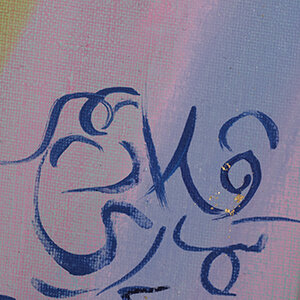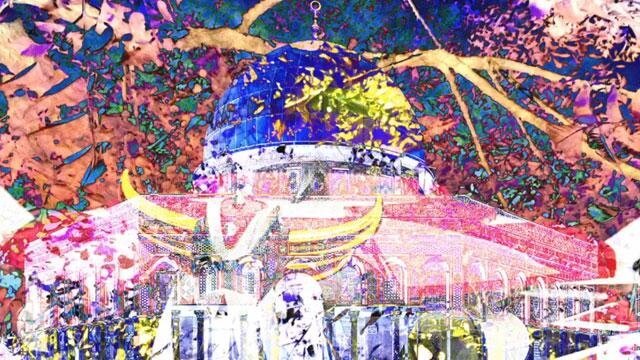


Last updated on Tue 23 October, 2018


Truth is black, write over it with a mirage’s light.
THIRD EXHIBITION OF OUR 30TH ANNIVERSARY CELEBRATION
23 OCTOBER 2018 – 14 MARCH 2019
For our 30th anniversary, we invited artists from all disciplines to pause and reflect, to re-imagine our world, and to reinvent their narrative, following the challenge set by Mahmoud Darwish in his poem ‘To a Young Poet’:
Truth is black, write over it
with a mirage’s light.
Three consecutive exhibitions were held over 2018, of which this is the closing one. As in the two previous iterations, this third exhibition does not offer one reading of the past or the present. The artists offer a multiplicity of perspectives and present a wide variety of practices that reflect the complexities of our world and our time. Together the exhibitions form a constellation of new narratives and interrogations, while allowing scope for paradoxes and intricacies to emerge.
In this third exhibition, we are presenting Ahlam Shibli’s photographic series ‘Occupation’ (2016/17). Recently shown as part of Documenta 14, the foundation of the work is the destruction of Palestinian livelihood in al-Khalil/Hebron and the occupied territories by the Israeli colonial regime and Zionist settlers. The photographs record the signs of a disturbing duplicate inversion, among other things. On the one hand, the images indicate how the settlers—who have invaded the Palestinians' territory, preventing them from using their property, and disrupted their freedom of movement—create a prisonlike space for themselves. On the other hand, the photographs reveal how the Palestinians use the hardware of the separation implemented by the Israeli occupation to protect their own public spaces and their homes.
Shot by drone across a perilous expanse, Hrair Sarkissian’s two-channel video installation, ‘Horizon’ (2016), charts one of the shortest and most common refugee routes from the Turkish shores to the island of Megisti on the edge of south eastern Greece. Sarkissian writes of this journey into the unknown as marked by extreme uncertainty wherein “there is just one line to hold on to: the horizon. It visualizes how close the future is, a starting point for building up hopes and dreams, a refuge for escaping the darkness of the present, while holding on to the memories of the past.”
In his new neon text sculpture, Adel Abidin outlines the title of a daring and challenging poem written by dissident Iraqi poet Muzaffar Al-Nawab in the mid-1970s that translates from the Arabic as ‘Jerusalem is the Bride of Your Arabhood’. It is a harsh and frank indictment that still reverberates today. James Webb’s ‘The Two Insomnias’ takes its title from 13th century poet Rumi. The work reframes and repurposes the poem, and seeks to untangle the relationships between nationalism, the individual, and the headiness of belonging. In a curious exploration of the nature of belief and the dynamics of communication, Webb’s video ‘Le Marché Oriental’ (2009) films the Azan (call to prayer) inside the empty remains of an Apartheid-era shopping mall a few weeks prior to its demolition to make way for luxury apartments.
In The Lab, Khalil Rabah presents ‘Member, Dismember, Remember’, an exhibition by the botanical department of ‘The Palestinian Museum of Natural History and Humankind’, his ongoing inquiry into the ways in which history is socially constructed through embedded material in identity and culture. Founded in 1995, the Museum is an institution that produces and presents artefacts and artworks dating to the present day. This ambitious long-term project sets out to disrupt iconic representations of Palestine.
The relationship between movement and space is highlighted in Studio 8’s journey through the history of dance notation and survey of the ties between dance and the visual arts.
Sima Zureikat reflects on a context of displacement and transformation through a photographic series shot in Jordan. In a similar vein, Mo’awia Bajis casts a lens on the city of Amman in an installation that archives sounds, which attest to the city’s political, social and cultural transformations and invites viewers to produce personal interpretations of the city’s identity through sound. Will Iskandar uses digital technology to cast a fresh eye on his immediate surroundings, and revisit ideas and principles anew.
Taking his profound interest in interrogating the familiar as a starting point, Ahmad Salameh’s film probes the human sense of humour in relation to social, historical and political contexts. Yousef Kawar’s installation immerses the public in what can best be described as an interactive room. Riccardo Matlakas presents a series of relics and documentation of his performance work, with an intent to re-formulate the current existing structures in society.
Students from the faculty of Fine arts at the University of Jordan have been working in our printing press workshops under the guidance of artist Jehad Al Ameri, head of the Visual Arts Department. They have been also designing items, mainly chairs, inspired from architectural elements at Darat al Funun under the guidance of Haifa’a Bani Ismail. Their works are exhibited in the Print Studios.
Participating artists in the October-March exhibition:
Adel Abidin (Iraq), Ahlam Shibli (Palestine), Ahmad Salameh (Jordan), Ammar Khammash (Jordan), Hrair Sarkissian (Syria), James Webb (South Africa), Khalil Rabah (Palestine), Mo’awia Bajis (Jordan), Riccardo Matlakas (Italy/UK), Sima Zureikat (Jordan/US), Studio 8 (Jordan), Yousef Kawar (Jordan), and Will Iskandar (Jordan/UAE), as well as print and design works by students from The University of Jordan.
At the Beit al Beiruti we display panels giving a timeline of our past 30 years of exhibitions and events, and exhibit works in remembrance of 25 artists from The Khalid Shoman Collection: Abderrazak Sahli, Adnan al Sharif, Ahmad Nawash, Ali Jabri, Ali Maher, Alia Amoura, Amal Kenawy, Aziz Amoura, Hassan Hourani, Fahrelnissa Zeid, Farid Belkahia, Fateh al Moudarres, Ismail Fatah, Ismail Shammout, Issam al Said, Jumana el Husseini, Mahmoud Taha, Marwan, Mohamed Kacimi, Nabila Hilmi, Nuha al Radi, Paul Guiragossian, Rafa’ al Nasiri, Shaker Hassan al Said, and Vladimir Tamari, as well as Thabiso Sekgala, who was part of HIWAR, our 25th anniversary exhibition. We also remember Zaha Hadid.
A musical performance by soprano Tania Tamari Nasir will follow the exhibition opening. She will reenact the very first concert held in 1993 at our archeological site after the inauguration of Darat al Funun, when she sang poems by the late Palestinian writer Jabra Ibrahim Jabra, set to music by composer pianist Agnes Bashir. Jabra traveled from Iraq to attend the concert in support of their innovative initiative. Modern ballet dancer Rania Qamhawi also took part in the performance. Now, for the closing event of our 30th anniversary, Tania and Agnes will perform three songs of the 1993 concert, followed by Tania singing two works by Amin Nasser, with Fadi Deeb on the piano. In the second part of the program, Tania's niece, soprano Mariam Vladimir Tamari, accompanied on the piano by Fadi Deeb, will sing a repertoire of French Art songs and her own compositions in Arabic. In the spirit of upholding continuity and the transfer of artistic experiences of one generation to another, Tania and Mariam will end the concert with a special duet arrangement of the song "Al Quds Arabia" together with lyricist and composer Rima Nasir Tarazi.
Join us in our endless discovery of modern and contemporary Arab art